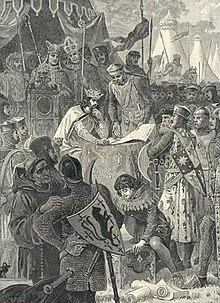Magna Carta
Main article: Magna Carta

The signing of the Magna Carta (1215)
Over the course of his reign a combination of higher taxes, unsuccessful wars and conflict with the Pope had made King John unpopular with his barons, and in 1215 some of the most important decided to rebel against him. He met their leaders along with their French and Scots allies at Runnymede, near London on 15 June 1215 to seal the Great Charter (Magna Carta in Latin), which imposed legal limits on the king's personal powers. Because he had sealed under duress, however, John received approval from the Pope to break his word as soon as hostilities had ceased, provoking the First Barons' War and an invited French invasion by Prince Louis of France (whom the majority of the English barons had invited to replace John on the throne and had him proclaimed king in London in May 1216). John travelled around the country to oppose the rebel forces, directing, among other operations, a two-month siege of the rebel-held Rochester Castle.
John's son, Henry III, was only 9 years old when he became king (1216–1272). He spent much of his reign fighting the barons over the Magna Carta[citation needed] and the royal rights, and was eventually forced to call the first "parliament" in 1264. He was also unsuccessful on the Continent, where he endeavoured to re-establish English control over Normandy, Anjou, and Aquitaine.
His reign was punctuated by numerous rebellions and civil wars, often provoked by incompetence and mismanagement in government and Henry's perceived over-reliance on French courtiers (thus restricting the influence of the English nobility). One of these rebellions—led by a disaffected courtier, Simon de Montfort—was notable for its assembly of one of the earliest precursors to Parliament. In addition to fighting the Second Barons' War, Henry III made war against Saint Louis and was defeated during the Saintonge War, yet Louis IX did not capitalise on his victory, respecting his opponent's rights.
دوست عزیز، به سایت علمی نخبگان جوان خوش آمدید
مشاهده این پیام به این معنی است که شما در سایت عضو نیستید، لطفا در صورت تمایل جهت عضویت در سایت علمی نخبگان جوان اینجا کلیک کنید.
توجه داشته باشید، در صورتی که عضو سایت نباشید نمی توانید از تمامی امکانات و خدمات سایت استفاده کنید.





.gif)


 پاسخ با نقل قول
پاسخ با نقل قول


علاقه مندی ها (Bookmarks)